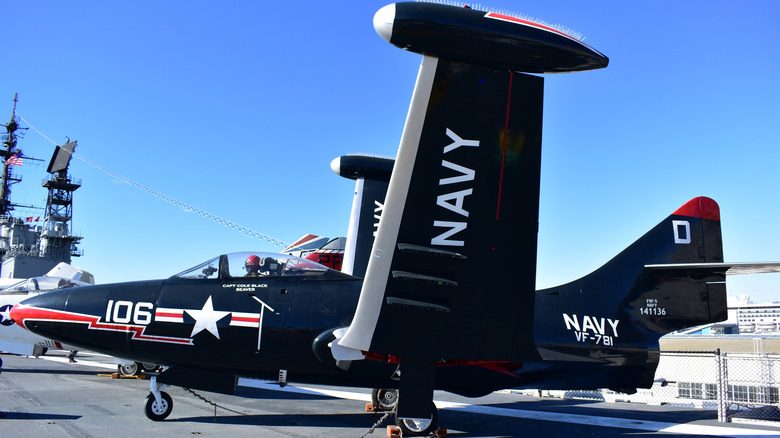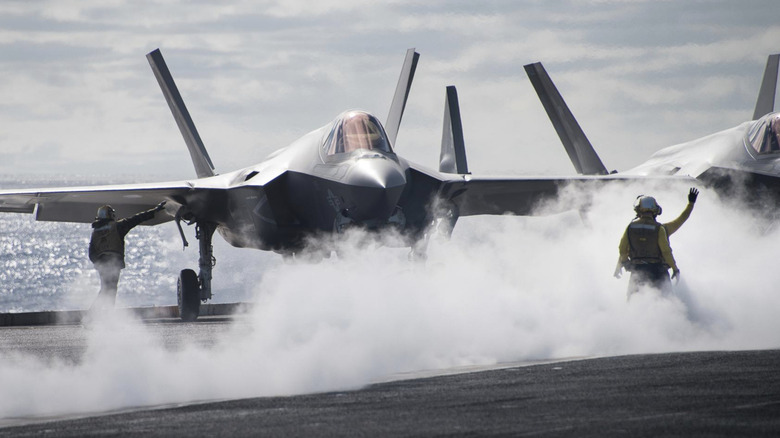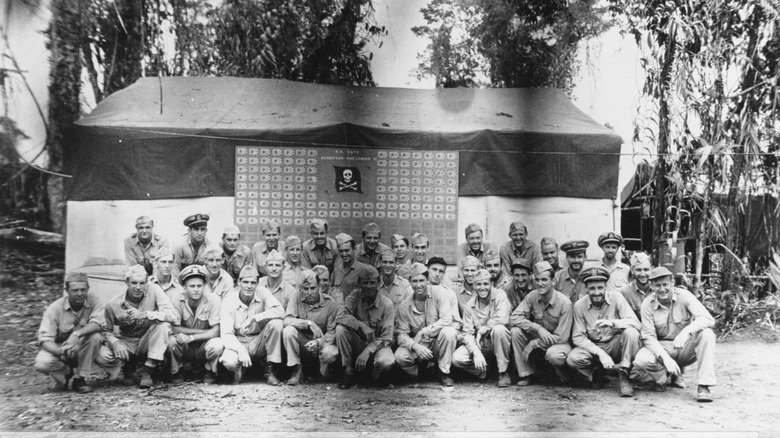What Does VF Stand For On Navy Squadrons?
The U.S. armed forces and other countries' militaries follow a system of designations for squads and armaments. While aviator call signs have been popularized by entertainment franchises such as "Top Gun," the defense wings also follow a codified system as well as informal naming conventions for squadrons as well as jets. For example, the F-35 famously goes by the name "Battle Penguin." In case you're wondering what odd letters, such as ZRP, HCT, and RVAH, stand for, well, they are all tactical squadron designations. One such notation that often pops up in discussions about the Navy is VF, with a rich history behind it.
According to the U.S. Naval Institute, the defense wing follows a letter-number designation system for squadrons. In VF, the letter "V" stands for a fixed-wing aircraft. It is derived from the Latin word "volare," which USNI explains means "to fly." Interestingly, mixed squadrons with fixed-wing aircraft and helicopters also take the "V" designation, while those consisting solely of helicopters go with the "H" identifier. The letter after "V" denotes the mission type. For example, in VF, the "F" stands for fixed-wing fighter squadron.
A derivative is VFA, which designates a Strike Fighter squadron. And if the squadron is linked to the Marines, the letter M is added to the designation name, and it becomes VMF. In addition to the squadron fighter designation and the unique number assigned to them, as in VF-1, the groups often take unofficial nicknames such as "Black Knights" and "Diamondbacks."
The significance of it all
The two-letter designation system, tagging alongside a numerical identifier, has been in place since 1922. Back then, the acronym "VF" was the official designation for Combat Squadron. Back then, F stood for fighting or Fighter. This is not too different from the approach followed by NATO, where the first letter of an unofficial name was usually the weapon type. Take, for example, the "Fishbed" nickname of the legendary MiG-21.
The letter "F" here stands for "fighter jet" classification, following in the footsteps of names such as Foxbat, Fencer, Fiddler, and Flogger, for other fighter jets. Likewise, names beginning with "B" were classifiers for bombers, and "H" stands for helicopters. Over the years, the designation system has undergone a few changes without changing the identifying letters as more types of weapons and combat aircraft were developed.
"VF-1 from World War II has no direct relationship to VF-1 established in the 1970s," explains (PDF) a training material courtesy of the US Navy. As per the latest rules, four criteria broadly dictate the designation names: mission, technical advances in aircraft, changes in tactics, and naval organizational changes. Circling back to the VF designation, it broadly referred to a fighter jet squadron, but has now shifted the official designation to "fixed-wing aircraft" squadron. The fundamental classification remains the same, as fighter aircraft rely on the fixed-wing design. The F-35C Lightning fighter jet you see in the picture above is operated by the "Argonauts" of Strike Fighter Squadron (VFA) 147, based on the USS Carl Vinson (CVN-70).
A bit of historical glory
Over the past century, multiple fighter squadron units have notched historical accolades in warfare. At the Battle of Midway in 1942, in which the U.S. Navy dealt a crushing blow to the Imperial Japanese Navy, the VF-3 "Felix the Cat" squadron executed the famous "Thach Weave" combat formation for the first time. Led by Lieutenant Commander John S. "Jimmy" Thach, the team switched to the VF-6 title and eventually morphed into the VFA-31 Tomcatters squadron. As part of the VF-3 Felix the Cat squadron, Lieutenant Edward H. "Butch" O'Hare became the first naval pilot to be awarded the Medal of Honor after shooting down five bombers.
The VFA-14 Tophatters, on the other hand, command a hundred-year operational history. Originally known by the name High Hats, it was home to Ensign Jesse Brown, the first African-American naval aviator in the U.S. Navy. Interestingly, squadronmate Lieutenant (j.g.) Tom Hudner was awarded the Medal of Honor for his heroic act to save Brown. The squadron continues to serve spiritually under the VFA-32 Swordsmen designation to this day.
Another famous name is the VF-17 Jolly Rogers, which was the first to fly the F4U Corsair fighter jet during World War II. This record-setting squadron downed 154 Japanese airborne vehicles in half the number of days. The legendary duo of Lieutenant Randall Cunningham and Lieutenant (j.g.) William Driscoll served in the VF-96 Fighting Falcons squadron, which held the record for destroying MiG fighter jets in the Vietnam War.


